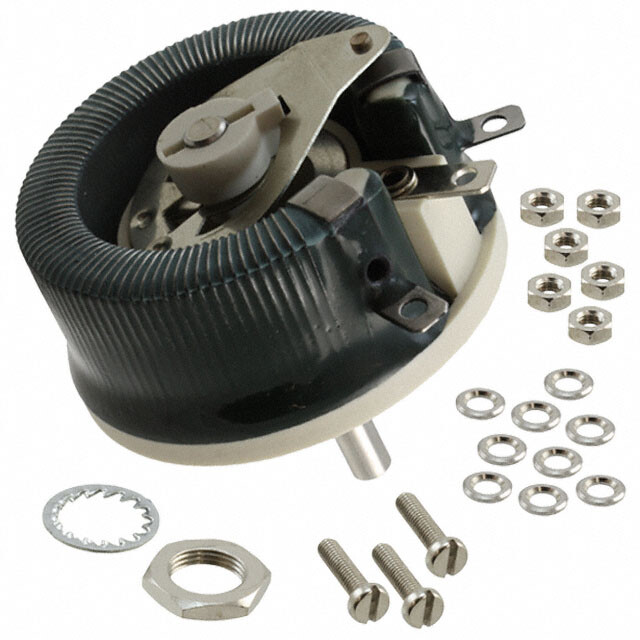This Product Selection Guide contains information to help select products in the Rotary Potentiometers, Rheostats category on DigiKey.com
A rotary potentiometer (Pot) is a three-terminal device that employs a resistive element and a rotating contact to form an adjustable voltage divider. If only two terminals are used, one end of the element and the adjustable contact, it acts as a variable resistor or rheostat. Potentiometers are selected by the resistance value of the element, degree of rotation/number of turns, linear or logarithmic taper, power dissipation, number of ganged elements, resistive material and termination style. Some have built-in switch contacts.
SelectionCharacteristics
Resistance (Ohms): Maximum device resistance at the indicated device temperature; subject to manufacturing variation within the listed resistance tolerance value for a device.
Tolerance: Characterizes the extent of permitted variability of overall device resistance among samples of a given part number, resulting from variations in manufacturing.
Power (Watts): Identifies the amount of heat that can be continuously dissipated by the resistive element without damaging the device. Measured in Watts (W) and typically based on the size of the device.
Built in Switch: Defines if and what type of switch is built into the potentiometer.
Number of Turns: Indicates the number of actuator rotations required to move a device through its full range of travel.
Features: These are different capabilities or properties of the device such as high torque or an illuminated shaft.
Taper: Characterizes the relationship between device resistance and knob position (or digital input code, for digital potentiometer devices).
Number of Gangs: The number of individual potentiometer circuits controlled by a single shaft within a device.
Adjustment Type: Defines what orientation the adjuster is placed at.
Temperature Coefficient: The temperature coefficient of resistance (TCR) is a constant representing the resistance change per degree Celsius of temperature change over a specific temperature range and expressed in ppm/°C (parts per million per degree centigrade).
Rotation: The angle through which a device’s actuator must be rotated to move from one end stop to the other.
Resistive Material: Indicates the material of which a device’s resistive element is constructed. Has general influence over traits such as rotational life, noise characteristics, power dissipation capability, and cost.
Termination Style: Selection of termination style used to connect the device to a system, such as PC pins, solder lugs, or wire leads.
Actuator Type: Defines the shape of the actuator for various knob styles.
Actuator Length: The length of the shaft or protrusion that serves as the mechanical interface for adjusting a device setting or value.
Actuator Diameter: The diameter of the actuator.
Bushing Thread : Indicates the thread specification of a device’s threaded mounting bushing, for products equipped therewith.
Mounting Type: Indicates how the device is attached.
ProductExamples
| MFR PART # | 450T328F103A1C1 |
|---|---|
| DIGIKEY PART # | CT3057-ND |
| MANUFACTURER | CTS Electrocomponents |
| DESCRIPTION | POT 10K OHM 1/2W CARBON LINEAR |
| DATASHEET | Click Here |
| MFR PART # | P091S-QC15BR50K |
|---|---|
| DIGIKEY PART # | 987-1284-ND |
| MANUFACTURER | TT Electronics/BI |
| DESCRIPTION | POT 50K OHM 1/20W PLASTIC LINEAR |
| DATASHEET | Click Here |
| MFR PART # | RT055AS2201KB |
|---|---|
| DIGIKEY PART # | RTAS-2.2KA-ND |
| MANUFACTURER | Vishay Sfernice |
| DESCRIPTION | POT 2.2K OHM 55W WIREWOUND LIN |
| DATASHEET | Click Here |
| MFR PART # | PRM162-K420K-103B1 |
|---|---|
| DIGIKEY PART # | PRM162-K420K-103B1-ND |
| MANUFACTURER | Bourns Inc. |
| DESCRIPTION | POT 10K OHM 1/10W CARBON LINEAR |
| DATASHEET | Click Here |
SchematicSymbol

Schematic symbol courtesy of Scheme-it. Please see their website for more information and symbols.
MediaLinks
TechForum
Linear vs Logarithmic Potentiometer Test - Passives
Potentiometer Linearity Tolerance - Passives
Temperature Coefficient and PPM Explanation
Overview of Potentiometers and Their Practical Applications




